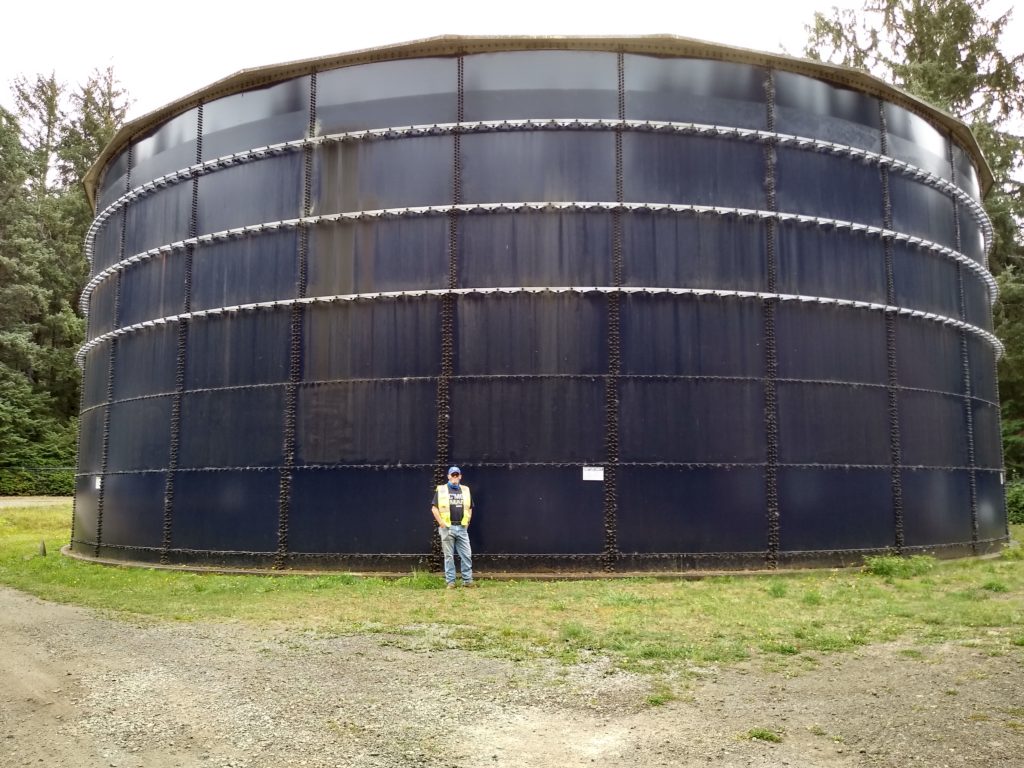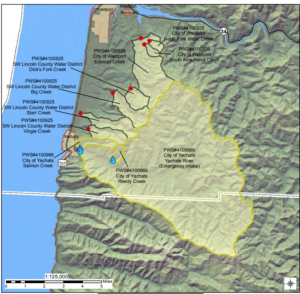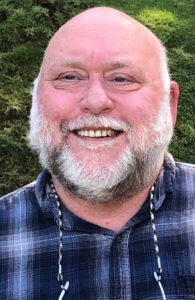
By KENNETH LIPP/YachatsNews
YACHATS — In what the mayor described as a monumental decision, the Yachats City Council voted unanimously Thursday to authorize the city manager to negotiate with a neighboring water district to regularly supplement the city’s supply.
“Over the last 25 years, water security has been the No. 1 topic for every council,” said Yachats water treatment plant operator Rick McClung during Thursday’s regular council meeting. “This council, I think, has the opportunity to achieve it.”
With that, McClung opened a report the council requested during its first meeting of the year on options to secure a water supply for lean months and to meet future demand. The city’s water comes from two creeks a few miles up the Yachats River valley that can run low in August and September.
McClung’s report, delivered with financial consultant Tom Lauritzen, presented three options and their potential costs. Those options are based on two 2021 city water plans, one dealing with overall operation of the system and the other with conservation and management.
The report eliminates the first option — adding an intake at the Yachats River, estimated in 2021 to cost $5 million.

“For a variety of reasons, the city does not wish to develop the Yachats River,” the report reads, leaving just two options.
The city could expand its raw water storage by buying eight acres near its treatment plant and building more tanks there, creating a “reservoir farm” next to an existing 500,000 gallon city tank. That could give the city another 1.5 million gallons of storage at a cost of about $4 million.
Ultimately, McClung told councilors Thursday, increasing storage capacity would just be a Band-aid. The best option would be an agreement to buy water from Southwest Lincoln Water People’s Utility District, an 8-by-1½ mile long mostly residential water district immediately to Yachats’ north. The city already has a connection to the district’s system and a longtime agreement to buy water during emergencies. A new agreement would let Yachats open the tap before supply reaches emergency levels and accommodate future growth in demand.
It’s not clear how much upgrading the connection between systems would cost. Both the district and city would likely need millions in infrastructure improvements, and additional staff would need to be hired.
The district says it could supply the city with 300 gallons per minute or 432,000 gallons per day. Peak usage for the city is about 250,000 gallons per day.
Southwest Lincoln PUD
Southwest Lincoln serves mostly residential customers within 1½ miles of the ocean in the unincorporated area between Yachats and Waldport. Its largest commercial customer is the sprawling Angell Job Corps campus south of Waldport.
Originally drawing on two sources, Starr Creek and Big Creek, the 75-year-old district enabled the first development of places like Wakonda Beach in the 1950s. Now it operates two water treatment plants and three reservoirs drawing on four sources, with the addition of Dick’s Fork and Vingie Creek.
Its raw storage capacity is about 1.8 million gallons, McClung said Thursday, not much more than Yachats’ 1.7 million gallons. But it has less peak-season demand.
Mayor Craig Berdie asked how often the city would use the district’s water.

McClung said a connection to Southwest Lincoln would be an opportunity to change restrictions on use during water emergencies. Water emergency restrictions are tied directly to flows in Yachats’ two creek sources.
Recalling a previous drought that threatened to prevent hotels from doing laundry, McClung said one hotel owner attempted to get laundry done in the valley. But no companies were interested in his business without a six-month contract. He considered bringing in water tanker trucks, McClung said.
“If we connected to Southwest Lincoln, that gives us the opportunity to rewrite the codes,” he said, perhaps basing emergency levels on the actual amount of water available or easing certain restrictions.
Having an extra 400,000 gallons a day would also allow the city to proceed with another project in the master plan — replacing its million-gallon concrete reservoir that is susceptible to earthquake-caused landslides.
“If we go to replace that, that leaves us a million gallons less storage,” McClung said. “I would suggest for at least a couple of years.”
He said a connection to the district would help the city feel safe taking the concrete reservoir offline and still fighting fires and providing services, “and we wouldn’t be in a catch-up mode.”
McClung said he and city manager Heide Lambert have been in regular communication with the water district about the potential agreement. They said the district wants to “keep it simple” — Yachats would just be a customer.
At Lambert’s prompting, McClung noted that the state was pushing for south county entities to form water partnerships and there could be funding available for such projects. He said Southwest Lincoln’s board is not interested in being involved with the Midcoast Water Planning Partnership.
“We could create our own regional (partnership),” Lambert said.
McClung said he’s always visualized Waldport, Southwest Lincoln and Yachats being one water system.
“Not today, we just want to be a customer. But in the future it’s just going to happen, we’re all going to be one water system,” he said.
Councilor Catherine Whitten-Carey asked if the city should still consider buying the eight-acre property for extra storage as well as buying Southwest Lincoln’s water.
“I suggest putting the concept of raw water storage on the shelf for right now, not throw it away,” McClung said. “We could still buy the property, because we could still put a water treatment plant up there or a public works shop building to hold more equipment. It still has benefits.”
Lambert said she would advise the council to consider buying property outside of the tsunami zone for raw water storage as well as a place to store heavy machinery needed for emergency recovery efforts.
Councilor Greg Scott suggested McClung enhance his report with a more detailed cost-benefit analysis of storage versus purchasing water by the gallon. He asked how long the extra storage would keep the system supplying water.
Lauritzen said that would depend on the inflow, because even in a drought some water is always coming into the system. He later noted that purchase of the eight-acre parcel was already part of the city’s capital improvement plan.
Lambert said the Public Works & Streets Commission unanimously recommended the council move to authorize her to negotiate an intergovernmental agreement with Southwest Lincoln. Scott eventually made that motion.
“I think this is monumental,” Berdie said, and he called for each councilor’s vote individually, with all voting “yes.”
At the mayor’s request, Lambert said she would schedule an executive session March 15 to discuss acquisition of the eight acre parcel.
- Kenneth Lipp is YachatsNews’ full-time reporter and can be reached at KenLipp@YachatsNews.com



Ahoy and very well written and thank you for doing research needed as such.
Larry Nixon – former Councilor
If the city buys water, what will it cost the consumers? Developing our own water system seems like a better idea. A connection of water to all the areas means a monopoly where they can raise water rates anytime they want.
As Southwest Lincoln Water customer I hope my quality and flow isn’t affected from more use if water is sold to Yachats.